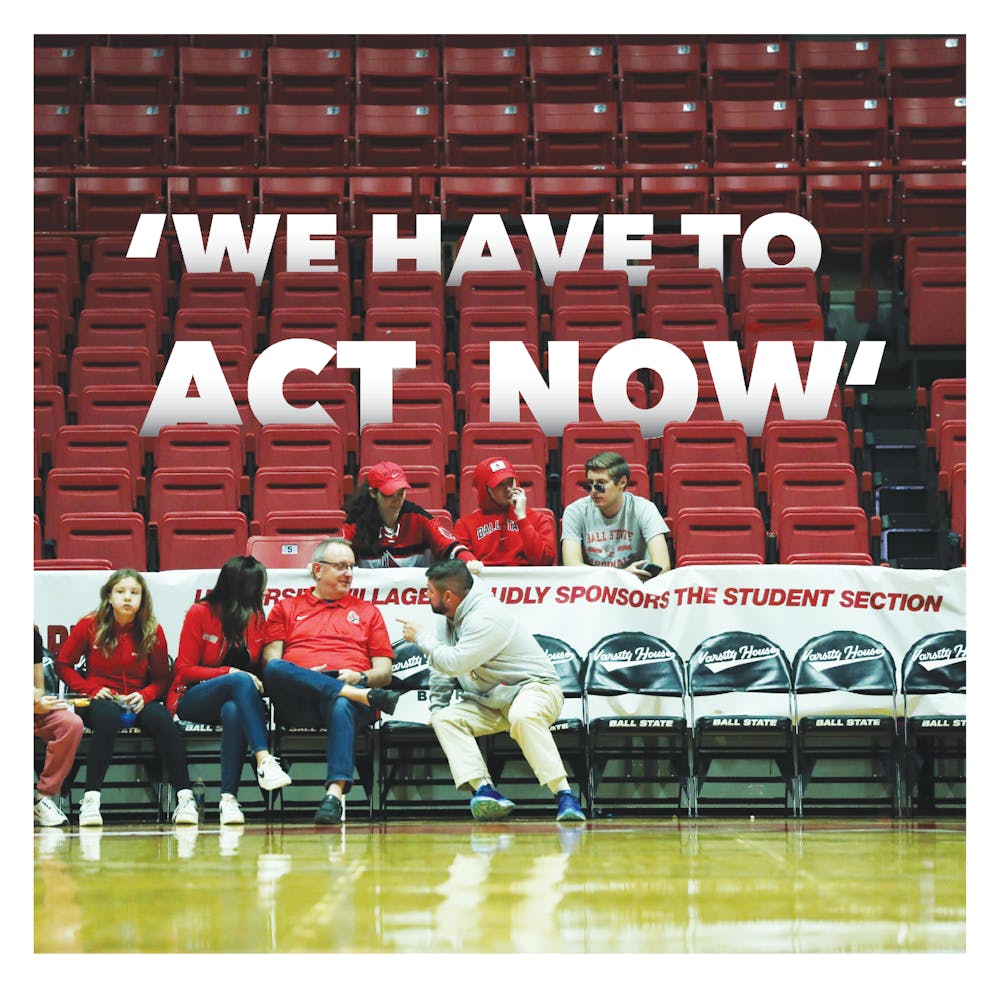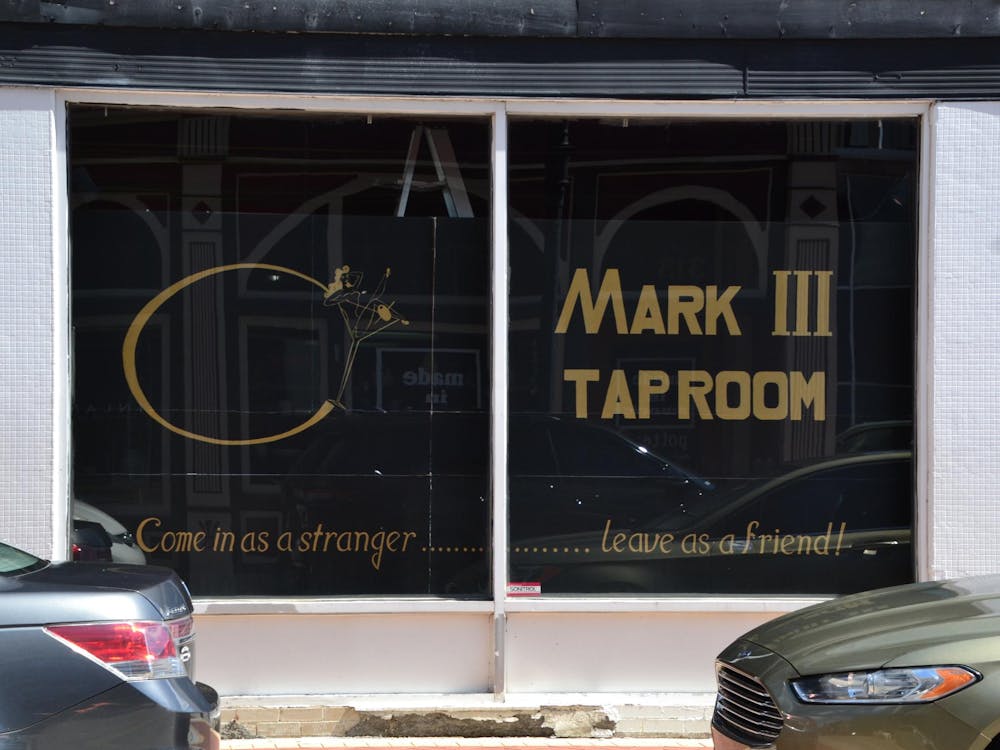Ben Carr said he grew up a Purdue University fan. A Zionsville native, Carr said he regularly attended basketball games at Mackey Arena and football games at Ross-Ade Stadium with consistently packed crowds.
Shortly after he enrolled at Ball State University in 2022, he was disappointed by the lack of fan support.
So, Carr came up with the idea for Cardinal Chaos during the first semester of his freshman year, presenting it to the former head of athletics marketing, Shawn Sullivan. Carr based much of his idea on Dayton University’s Red Scare, a similar student-led fan engagement group at a university similar in size to Ball State.
After Sullivan left Ball State in early 2023, Matt Brown, the director of ticket services, picked up Carr’s idea and started to get the ball rolling. Eventually, the idea was passed to Sullivan’s replacement, Kevin Mullaney, who finally got Cardinal Chaos off the ground at the start of the 2023 semester and Carr’s sophomore year.
Michael Lewis, men’s basketball’s head coach, has been the most outspoken about bringing more Ball State fans to Worthen Arena. He consistently ran promotions for ticket vouchers granting free hot dogs, pizza or beer to the first number of fans to come to a home Cardinals contest last season and has continued it into his second season.
Lewis even took on the unofficial title of “Campus Party Planner” and has carried that over to his second season as coach. Jeff Mitchell, Ball State’s new Director of Athletics, wants to continue to support people like Carr and Lewis in their efforts to increase attendance.
On Mitchell’s first day at Ball State back in April, he stood on the floor in Worthen Arena looking at approximately 11,500 empty seats. Since he arrived in Muncie, Ball State’s 15th director of athletics has made it a point of emphasis to fill those seats.
He started by piggybacking off men’s basketball head coach Michael Lewis’ efforts to increase attendance, which resulted in average attendance rates at Worthen Arena jumping from 3,203 per game in 2021-22 to 4152 per game in 2022-23. The first of many ideas to come to fruition since Mitchell’s takeover was born: sell courtside seats at Worthen, something that had never been done before.
Mitchell said once tickets went on sale before the men's and women’s basketball season started in fall 2023, courtside seats sold out almost immediately. However, a problem with attendance still exists on a larger scale across Ball State athletics.
The highest reported attendance for a football game at Scheumann Stadium this season was 15,171, a far cry from the estimated 22,500-fan capacity. The most fans Ball State football has hosted in the past decade was 18,329 during a family weekend contest against Toledo in 2013.
“We have to act now,” Mitchell said. “We are offering an entertainment option for Muncie and East Central Indiana, we’ve got to tell that story better.
“We have to perform better, we have to recruit better and we have to sell Ball State in a different way.”
The root of the problem

Fans sit to watch Ball State football play against Kent State Nov. 18 at Scheumann Stadium. Mya Cataline, DN
Mitchell believes every university the size of Ball State struggles with consistent attendance. However, more than half of the schools in the Mid-American Conference (MAC) average higher attendance numbers at home football games. Only two of the 12 host cities have a larger population than Muncie.
Greg Miller, a former men’s basketball player on the 1990 Sweet 16 team, posed the question: What is the fans’ reason to be there?
Miller’s son, Riley, played for the football program from 2015-19. As a parent, Miller said he looked for positive momentum when finding reasons to go to sports outside of football; how the players interacted with each other, win or lose. He feels like the men’s basketball team has that right now.
“I want to watch something with momentum, something rolling down the tracks at a high speed,” Miller said. “Winning has a lot to do with bringing people in. They want to be a part of it.”
That was something former Ball State football head coach Pete Lembo said was hard to do consistently during his 2011-15 tenure. Lembo was on the sidelines for the Cardinals’ highest-attended game in more than 10 years, but it was in the midst of a 10-3 season.
Lembo said he feels like being the head coach for Ball State football is one of the most challenging jobs in the MAC. That’s why the Cardinals are on their sixth coach in the past 30 years, and none of them have more than two winning seasons.
During that three-decade span, Ball State has only had eight winning seasons, ranking eighth in the MAC. Part of the struggle of piecing together a consistent winning culture came down to recruiting, Lembo said.
“A kid has got to pass by three or four MAC schools in Ohio before he comes to Ball State,” Lembo said. “The same could be true of a kid up in Michigan or perhaps in Chicago.”
Because of this, he doesn’t think many of Ball State’s students grew up as fans of the Cardinals, even if they were from Indiana. Instead, they’d likely choose to support universities like Notre Dame or Indiana.
Despite being a Muncie native, Miller didn’t feel like this was a valid excuse for low attendance.
“Everybody's from somewhere,” Miller said. “But that doesn’t mean people can’t go watch their teams at the college they’re at. We gotta have a product that people want to see.”
However, during games like the 2013 contest against Toledo that saw nearly 19,000 fans pack Scheumann Stadium, Lembo said the increased attendance during winning seasons certainly helped appeal to recruits.
“I tried to create a culture where everyone felt like we were in it together and that the success of the town and the success of the university and the athletic program were all tied together,” Lembo said. “You're fighting a lot of history there.”
Although Mitchell and past athletic directors have been on board with encouraging students and the Muncie community to attend more games, Lembo said it was difficult for the athletic department to get ideas rolling with the constant turnover in the athletic director’s (AD) chair. During his six seasons as head coach of the Cardinals, Lembo worked under three different ADs: Tom Collins (2005-12), Bill Scholl (2012-15), Mark Sandy (2015-18).
Mitchell took over in early 2023 after Beth Goetz (2018-22) left for the University of Iowa and is the seventh Ball State AD since 2000.
Alternative perspectives

Julie Cromer, the Director of Athletics for Ohio University since 2019, said the football program’s consistent winning has helped her and the entire athletic department consistently keep the ball rolling on ideas to allow fans to enjoy the overall gameday experience, regardless of the result. Ohio has had 14 winning seasons in the past 30 years.
She said the department encourages fans to come into Athens, Ohio, and go to a local farmer’s market, grab lunch just two blocks away from the stadium and go to a tailgate event before the game even starts.
Some other things Cromer considers when it comes to marketing for higher attendance at home games include local gas prices, ticket prices, prices of other entertainment options in the area, strength of schedule and more. Cromer said Ohio has not raised ticket prices of their sporting events even in the midst of current economic inflation.
“I don’t want to overextend a family of four, because they’re facing increases across every part of their gameday experience,” Cromer said.
Ohio’s football tickets are $34 online and $40 at the ticket office on game day. Ball State football’s range from $10-27 in advance, fees not included, whereas gameday tickets range from $10-30.
Ohio, similar to Ball State, only sells tickets for football, men’s and women’s basketball, women’s volleyball and wrestling. However, Cromer said the department is looking into potentially ticketing its Olympic sports such as swimming/diving and track/field.
Carr said Cardinal Chaos is only technically “required” to attend ticketed sports like football, men’s and women’s basketball, men’s and women’s volleyball and gymnastics. However, they try to attend every sport they can and those sports, such as field hockey, have expressed gratitude for their support.
“It’s not just six sports, it's athletics as a whole. You look at places like IU; they have 24 varsity sports, and they get people to come out to all of them,” Carr said. “The hope is that we start building up a culture where fans are willing to come out to these events, and I think that brings the university closer as a whole.”
Emma Hilton, Ball State field hockey junior, said most of the only people who come to her team’s games are partners, friends or family members of teammates. However, attendance at sporting events at Ball State has actually been larger than she expected.
In the one field hockey match Cardinal Chaos attended, Hilton scored the game-winning goal against IU.
“Having the support from a lot of people in the stands, getting that energy, is huge,” Hilton said. “If energy shifts in the wrong direction, things can really take a turn.”
While she has recognized the efforts Ball State Athletics is putting forward to increase attendance at ticketed events – even saying the increased promotion for sports like women’s volleyball has driven her and some of her roommates to attend more games – she thinks the department should expand things like giveaways to non-ticketed events such as field hockey. She said increased attendance at such events would increase awareness for an undercovered sport in the Midwest.
“I think people being able to see something they aren’t familiar with is really beneficial,” Hilton said.

Lembo said there is no doubt fan support gives players extra motivation.
Even when the University of South Carolina, where he currently serves as associate head coach, has a down year, the GameCocks still see around 40,000 fans for their spring exhibition game and nearly sell out Williams-Brice Stadium for each home game.
“I remember doing Cardinal walks in front of 200 or 300 people; We do our GameCock walks here in front of 10,000 people,” Lembo said.
Nyla Hampton, a junior women’s basketball player, spoke about the value of crowd energy.
“It fuels you in every step you take,” Hampton said.
Hampton transferred to the program from MAC-rival Bowling Green. During her three seasons with the Falcons, Hampton played at Worthen Arena three times.
Hampton acknowledged women’s basketball rarely gets the same attention or attendance as men’s, but said it isn’t a “sore spot” because she has never known anything else.
However, she still wants to try and change that narrative.
“If we can get them here, I think it'll be like, ‘This is a really fun group [that is] really fun to watch,’” Hampton said. “Getting them to their first game is the biggest step to get ourselves out in the community being seen and connected.”
Miller wants to see more players make efforts off the court to get fellow students to come to games. Though he acknowledged the potential struggles of a first-year or transfer player in building community, Miller wondered if players are making relationships with classmates to see if a friendship can be kindled and perhaps bring them to a game.
“Players are young, and they want to see people in the stands,” Miller said. “They want to hear that noise.”
Hampton said when she was a student at Bowling Green, she encouraged classmates to come support the Falcons the next time they had a home game. Even during her short time at Ball State, she has started to do the same.
“I haven't come across a single person that hasn't been open to coming and watching,” Hampton said.
Cromer said Ohio does a lot of marketing via social media or email, similarly to Ball State. Those who sign up for emails may receive gameday promotion leading up to home events. That said, ticketed sports do have more funding going into the marketing than non-ticketed sports.
Moving forward
Carr said he hasn’t noticed a lot of tradition between Ball State Athletics and the university’s students. However, he wants to build that up through Cardinal Chaos.
“It’s basically creating an environment that's fun and welcoming for students that maybe we haven't had in the past,” Carr said.
Conversely, Miller doesn’t feel like tradition is a problem at Ball State. He said it depends on what each fan is looking for. He finds that Ball State does a good job of promoting players and promoting teams, yet he doesn’t know if it’s a two-way street.
“I think the tradition comes from who’s in the jersey,” Miller said.
Despite his reasoning for why he believes Ball State struggles with consistently getting high attendance, Lembo feels like there is light at the end of the tunnel with the efforts Ball State currently has in place.
“I don't think anybody should ever lose hope,” Lembo said. “I do think it would make it a better place to live and work and go to school if you had that kind of symmetry.”
Mitchell said part of the struggle with getting people to attend sporting events more regularly is the emergence of a seemingly “saturated” entertainment market, especially with Muncie having the third-largest population in the MAC with more than 65,000. While Athens has the fourth-lowest population in the MAC at just more than 24,000, it is one of the largest in its area of the state. In that sense, the university serves as not only the center of Athens but the center of the entire region.
This actually allows for better community engagement than perhaps in larger cities like Muncie or Kalamazoo, which have more things to offer to the community in terms of entertainment.
Cromer does credit some of Ohio’s strong attendance to the athletic department’s strong sense of winning and tradition. The football team has only lost one home game over the past two seasons, and does more than just promote family weekend and homecoming; Ohio hosts a dad’s weekend and a high school marching band day as well.
“Team culture, winning culture and learning how to win is something that we’re all teaching as part of the student-athlete experience regardless of whether or not we’re selling tickets,” Cromer said.
Mitchell drew on his experience at Southern Mississippi (Sun-Belt Conference) and Santa Clara (West Coast Conference) to prove improved attendance and successful athletic culture is attainable at the mid-major level, whether its programs are consistently winning or not.
Hattiesburg, Mississippi, has a population of nearly 49,000, significantly less than Muncie, yet in Mitchell’s final full-year at Southern Miss, the football program averaged 23,259 fans per home game with a 3-9 record, playing at M.M. Roberts Stadium with a capacity of 36,000. However, Southern Miss has had 24 winning seasons in the past 30 years.
While Ball State football averaged just 10,772 fans per game in 2023, down nearly 1,000 from 2022’s average of 11,637, Mitchell didn’t say these declining numbers have a negative effect on Ball State athletics’ fiscal bottom line. However, he recognized improvement needs to be made.
“What I won't give up on is creating the environment that is going to be enjoyable for fans and the other experiences that go along with it,” Mitchell said. “I'm willing to be stubborn and do things over and over again to create this atmosphere.”
Mitchell said the marketing team’s focus is on ensuring that a two-year-old and a 92-year-old could get the same enjoyment out of attending a Ball State sporting event. That said, he recognized the most accessible market to athletics’ push for higher attendance is the students in Muncie.
“It's a missed opportunity if you don't partake,” Mitchell said. “Students can develop a really significant foundation if they get involved while on campus, and one of the ways to do that is to go to sporting events.”
Contact Kyle Smedley with comments via email at kyle.smedley@bsu.edu or on X @KyleSmedley_.





